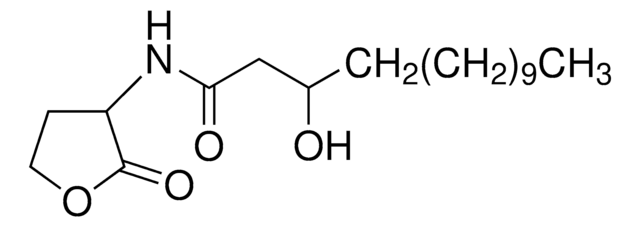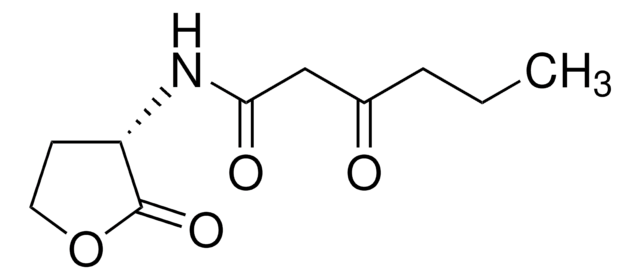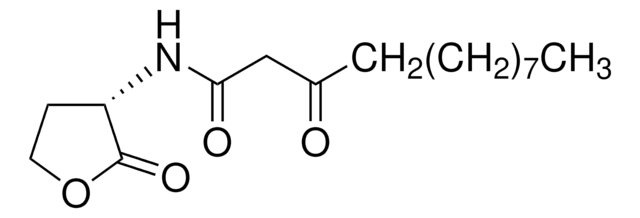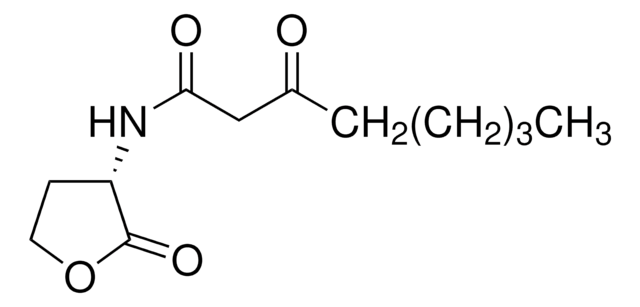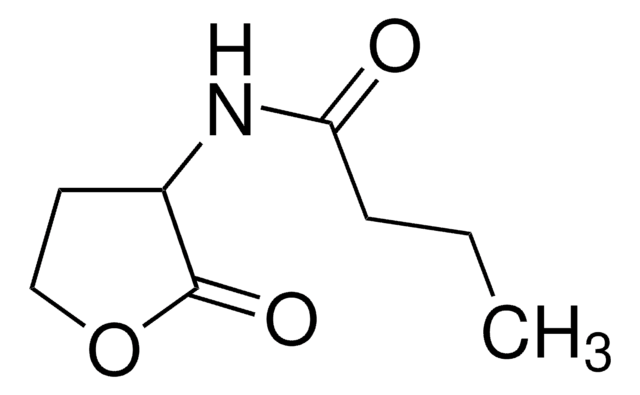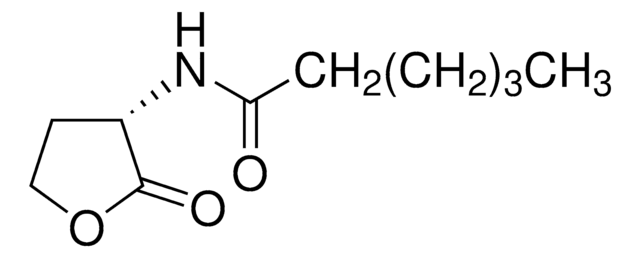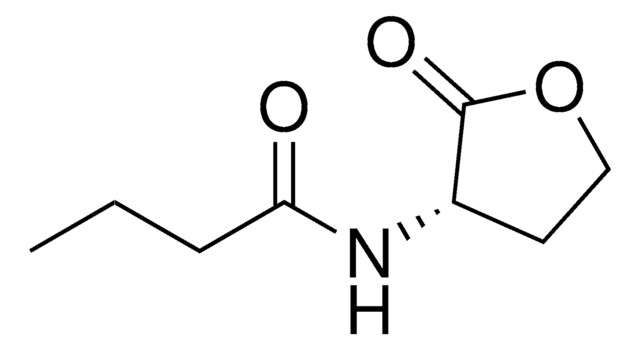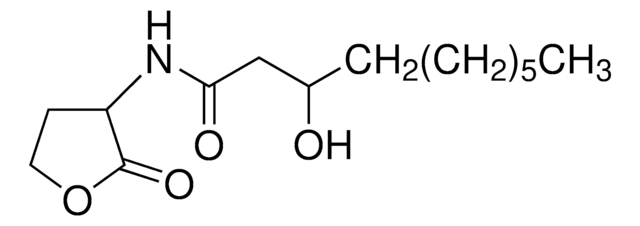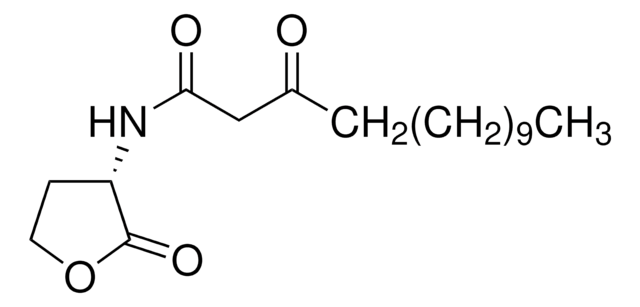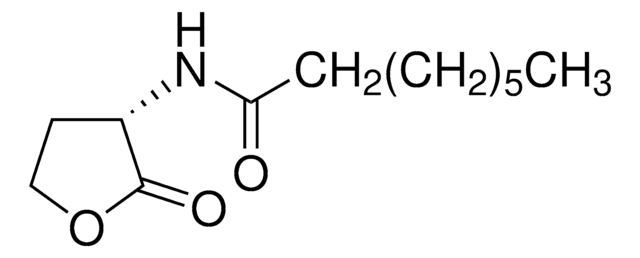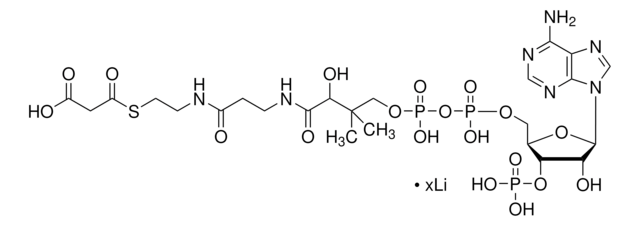07077
N-(p-Coumaroyl)-L-homoserine lactone
≥94% (HPLC)
Synonym(s):
p-Coumaroyl (S)-(−)α-amino-γ-butyrolactone, pC-HSL
Sign Into View Organizational & Contract Pricing
All Photos(1)
About This Item
Empirical Formula (Hill Notation):
C13H13NO4
Molecular Weight:
247.25
MDL number:
UNSPSC Code:
12352209
PubChem Substance ID:
NACRES:
NA.25
Recommended Products
Quality Level
Assay
≥94% (HPLC)
form
powder
optical activity
[α]/D -23.0±3.0°, c = 1% in ethanol
color
white to off-white
mp
201.2 °C
application(s)
cell analysis
storage temp.
2-8°C
SMILES string
Oc1ccc(\C=C\C(=O)N[C@H]2CCOC2=O)cc1
InChI
1S/C13H13NO4/c15-10-4-1-9(2-5-10)3-6-12(16)14-11-7-8-18-13(11)17/h1-6,11,15H,7-8H2,(H,14,16)/b6-3+/t11-/m0/s1
InChI key
CCIXZFJYFQJTGK-GQOHGMTASA-N
Application
N-(p-Coumaroyl)-L-homoserine lactone, or pC-HSL, can be used to study microbiology, quorum sensing and signaling compounds. pC-HSL has been used to study the activity of the Rhodopseudomonas palustris p-coumaroyl-homoserine lactone-responsive transcription factor RpaR.
Biochem/physiol Actions
New type of bacterial, quorum sensing signal compound. Quorum sensing mechanism has been investigated in Rhodopseudomonas palustris, but the signal compound has been discovered in other bacteria such as Bradyrhizobium sp. or Silicibacter pomeroyi.
Packaging
Bottomless glass bottle. Contents are inside inserted fused cone.
Storage Class Code
11 - Combustible Solids
WGK
WGK 3
Flash Point(F)
Not applicable
Flash Point(C)
Not applicable
Personal Protective Equipment
dust mask type N95 (US), Eyeshields, Gloves
Choose from one of the most recent versions:
Already Own This Product?
Find documentation for the products that you have recently purchased in the Document Library.
Customers Also Viewed
Hidetada Hirakawa et al.
Journal of bacteriology, 193(10), 2598-2607 (2011-03-08)
The Rhodopseudomonas palustris transcriptional regulator RpaR responds to the RpaI-synthesized quorum-sensing signal p-coumaroyl-homoserine lactone (pC-HSL). Other characterized RpaR homologs respond to fatty acyl-HSLs. We show here that RpaR functions as a transcriptional activator, which binds directly to the rpaI promoter.
Amy L Schaefer et al.
Nature, 454(7204), 595-599 (2008-06-20)
Quorum sensing is a term used to describe cell-to-cell communication that allows cell-density-dependent gene expression. Many bacteria use acyl-homoserine lactone (acyl-HSL) synthases to generate fatty acyl-HSL quorum-sensing signals, which function with signal receptors to control expression of specific genes. The
Nicolas Kylilis et al.
Nature communications, 9(1), 2677-2677 (2018-07-12)
Advancing synthetic biology to the multicellular level requires the development of multiple cell-to-cell communication channels that propagate information with minimal signal interference. The development of quorum-sensing devices, the cornerstone technology for building microbial communities with coordinated system behaviour, has largely
Sun-Young Kang et al.
Microbial cell factories, 14, 191-191 (2015-11-27)
Quorum sensing (QS) networks are more commonly known as acyl homoserine lactone (HSL) networks. Recently, p-coumaroyl-HSL has been found in a photosynthetic bacterium. p-coumaroyl-HSL is derived from a lignin monomer, p-coumaric acid, rather than a fatty acyl group. The p-coumaroyl-HSL
Our team of scientists has experience in all areas of research including Life Science, Material Science, Chemical Synthesis, Chromatography, Analytical and many others.
Contact Technical Service